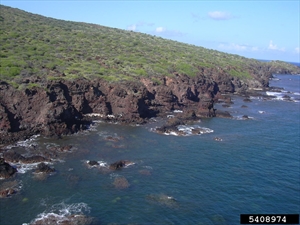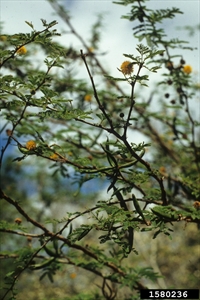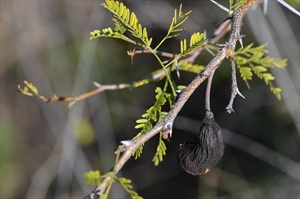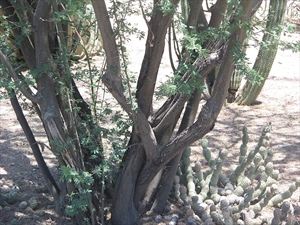Mimosa bush. It is also known as Ellington's curse (Fiji), huisache (a Spanish word for 'many thorns'), sweet acacia, cassie flower. CABI prefers huisache.
Pacific Pests, Pathogens, Weeds & Pesticides - Online edition
Pacific Pests, Pathogens, Weeds & Pesticides
Mimosa bush (489)
Acacia farnesiana; it was previously known as Vachellia farnesiana, Acacia minuta, and Mimosa farnesiana. It is a member of the Fabaceae. Note, that Jerusalem thorn is similar, has spines, and is also a member of the Fabaceae (see Fact Sheet no. 442).
Asia, Africa, North, South and Central America, the Caribbean, Europe, Oceania. It is recorded from Australia, Cook Islands, Fiji, French Polynesia, Guam, Kiribati, Nauru, New Caledonia, Northern Mariana Islands, Palau, Solomon Islands, and Vanuatu. Considered a native of North America, although a much wider area from Brazil to Mexico is also suggested.
An important invasive spiny shrub or small tree, forming thickets (Photo 1); it has been introduced to all tropical and subtropical regions. Thrives in a variety of different soils, saline, acid, or alkaline, whether clays, loams or sandy. Prefers full sun to shade and low rainfall (although it tolerates high rainfall where accompanied by long dry seasons). Tolerant to drought, fire and frost. Common habitats include natural and managed grasslands, creeks and riverbanks, disturbed areas - wastelands, as well as cultivated agricultural land.
Fast-growing, upright or spreading tree, deciduous in part of its range, thorny, with several stems and thin branches, growing to 7 m (Photo 2). Leaves yellowish-green with 2-8 paired leaflets which divide into 10 or more pairs of smaller leaflets (called pinnae), 2-7 mm long, 0.75-1.75 mm wide (Photos 3&4) . Flowers, yellow, fragrant, in clusters, arising from the leaf forks, on hairy stalks (Photo 3). Stamens (male parts) obvious giving hairy look. Stems, brown to grey, slightly rough, with many long sharp thorns (Photo 5). Seed pods, cigar-shaped, up to 8.5 cm long and 17 mm wide, green then black when ripe, containing about 10 brown seeds.
Spread is by seed, dispersed by livestock that pass through the intestine intact. The tree can also resprout from the base when it is damaged. Long-distance spread is associated with deliberate movement as a fodder crop, and for its scented flowers.
Mimosa bush is considered an environmental weed in many parts of Australia. It is also of economic interest as it forms thorny thickets that interfere with mustering and prevents stock from accessing water. Furthermore, it can have social impacts, preventing land from being used for recreational purposes because of the presence of its thorns. Thickets of the bush also form habitats for wild pigs.
All parts of the trees are used: extracts from the flowers are used in perfumes, scented hair oil, and as food flavours; stems are traded for their flowers, provide gums; bark is used for dying and tanning leather; seeds are eaten after roasting; and the wood is used in the manufacture of ships, carts, and furniture. Also, the tree is planted as an animal feed (protein content is about 18%), an ornamental, for hedges and windbreaks. There are many medicinal preparation made from the leaves, flowers and bark, especially for coughs, bleeding gums and, in livestock, for skin diseases.
BIOSECURITY
There is a high risk of introduction of this weed. Countries not yet infested by mimosa bush should consider all likely pathways for entry, and apply quarantine measures accordingly. Particular attention should be paid to its use as a fodder species, it use as an ornamental, and commercial uses such as an ingredient in perfumes.
Acacia farnesiana is on the Global Invasive Species Database (2021) of information on alien and invasive species that negatively impact biodiversity, managed by the Invasive Species Specialist Group of the IUCN Species Survival Commission: (http://www.iucngisd.org/gisd/speciesname/Acacia+farnesiana).
CULTURAL CONTROL
- Physical & Mechanical:
-
Hand-weed seedlings, and dig out small trees, but be careful of the thorns!
-
Use slashing as a control, but follow up with herbicide treatment to kill regrowth.
-
Use a large heavy chain dragged across the ground by machinery to pull out mature trees. It is NOT suitable for uneven ground or along riverbanks as it can cause erosion and damage non-target species. Alternatively, push out plants with a tractor blade. Follow up with a herbicide treatment, or by ploughing. Where possible, crop the land, or plant perennial pasture afterwards.
-
Any machinery used in infested areas should be thoroughly cleaned before moving to areas uninfested by the weed.
-
-
Livestock:
- Quarantine livestock for at least 1 week between moving them from mimosa bush-infested areas to those without the weed.
- Use sheep (goats and camels) to keep mimosa bush under control, if practical.
CHEMICAL CONTROL
Herbicides should be applied when the trees are growing actively, generally in the hot, wet season. They are not recommended near waterways. Those treatments recommended by the Queensland Government are:
- Cut stems close to the ground and quickly (within 15 second) apply a herbicide to the cut surface.
- Spray the bark with herbicide to about 30 cm above ground, for smaller trees (up to 15 cm diameter); for larger trees, spray up to 1 m.
In Australia, the following are among those herbicides registered for use on mimosa bush: diuron; metsulfuron-methyl; glufosinate-ammonium; dicamba; tebuthiuron; fluroxypyr; aminopyralid + metsulfuron-methyl. Minor use permits have been given for: clopyralid; fluroxypyr; and triclopyr.
--------------------
Note, in the EU, approval to use glyphosate ends in December 2022; its use after that date is under discussion.
____________________
When using a pesticide, always wear protective clothing and follow the instructions on the product label, such as dosage, timing of application, and pre-harvest interval. Recommendations will vary with the crop and system of cultivation. Expert advice on the most appropriate herbicides to use should always be sought from local agricultural authorities.
AUTHOR Grahame Jackson
Information from CABI (2019) Acacia farnesiana (huisache). Crop Protection Compendium. (https://www.cabi.org/cpc/datasheet/2236); and Tahun U, Toran-Purba AV (2020) Acacia farnesiana (PROSEA). Pl@ntUse. (https://uses.plantnet-project.org/en/Acacia_farnesiana_(PROSEA)#:~:text=in%20the%20Americas.-,A.,and%20by%20women%20after%20childbirth); and from Mimosa bush Acacia farnesiana (2020) The State of Queensland, Department of Agriculture and Fisheries (https://www.daf.qld.gov.au/__data/assets/pdf_file/0007/74167/mimosa-bush.pdf). Photo 1 Forest and Kim Starr, Starr Environmental, Bugwood.org. Photo 2 John Ruter, University of Georgia, Bugwood.org. Photo 3 Maksim. (https://commons.wikimedia.org/wiki/File:Acaciafarnesiana1web.jpg). Wikipedia Commons. Photo 4 Margaret R Donald Vachellia farnesiana, Tarlee Road, Edgerol, inland, NSW. Photo 5 Don AW Carlson Acacia farnesiana Bark (synonym Acacia minuta) Phoenix Desert Botanical Gardens.
Produced with support from the Australian Centre for International Agricultural Research under project HORT/2016/185: Responding to emerging pest and disease threats to horticulture in the Pacific islands, implemented by the University of Queensland and the Secretariat of the Pacific Community.








